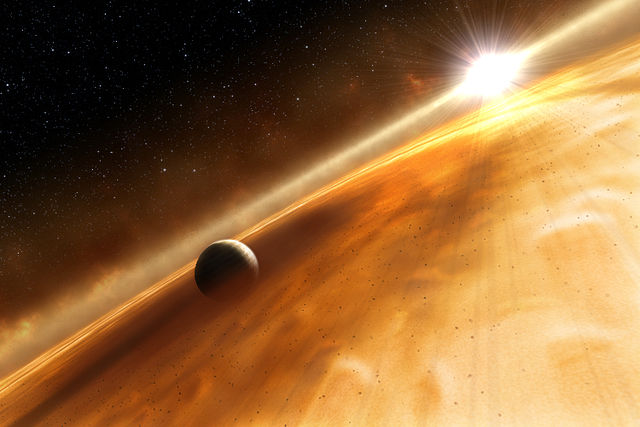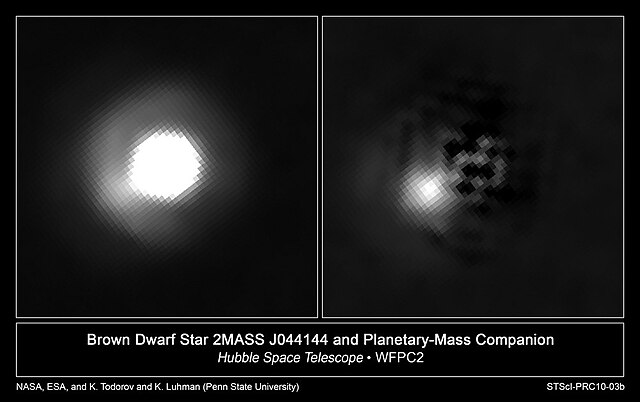Extrasolar planet
any planet beyond the Solar System From Wikipedia, the free encyclopedia
Remove ads
An extrasolar planet (or exoplanet) is a natural planet in a planetary system outside our own solar system. A related concept is an exomoon, a natural satellite orbiting an exoplanet.





In 2013, estimates of the number of terrestrial planets in the Milky Way ranged from at least 17 billion[1] to at least 144 billion.[2] The smaller estimate studied planet candidates gathered by the Kepler space observatory.[3] Among them are 461 Earth-size planets, at least four of which are in the "habitable zone" where liquid water can exist. One of the four, dubbed Kepler-69c, is a mere 1.5 times the size of the Earth and around a star like our own Sun – about as near as the current data allow to finding an "Earth 2.0".[4]
Earlier work suggested that there are at least 100 billion planets of all types in our galaxy, an average of at least one per star. There are also planets that orbit brown dwarfs, and free-floating planets that orbit the galaxy directly just as the stars do. It is unclear whether either type should be called a "planet".[5][6][7]
Analogies with planets in the Solar System apply to few of the extrasolar planets known. Most are quite unlike any of our planets, for example the so-called "hot Jupiters".
Remove ads
History
Early speculations
In the sixteenth century, the Italian philosopher Giordano Bruno, an early supporter of the Copernican theory that the Earth and other planets orbit the Sun, put forward the view that the fixed stars are similar to the Sun and are likewise accompanied by planets. Bruno was burnt at the stake by the Holy Inquisition.[8]
In the eighteenth century, the same possibility was mentioned by Isaac Newton in his Principia. Making a comparison to the Sun's planets, he wrote "And if the fixed stars are the centres of similar systems, they will all be constructed according to a similar design and subject to the dominion of One".[9]
Confirmed discoveries
The first published and confirmed discovery was made in 1988.[10] It was finally confirmed in 2002.
In 1992, radio astronomers announced the discovery of planets around a pulsar.[11] These pulsar planets are believed to have formed from the unusual remnants of the supernova that produced the pulsar, in a second round of planet formation. Otherwise they may be the remaining rocky cores of gas giants that survived the supernova and then decayed into their current orbits.
On October 6, 1995, Michel Mayor and Didier Queloz of the University of Geneva announced the first definitive detection of an exoplanet orbiting an ordinary main-sequence star (51 Pegasi).[12] This discovery, made at the Observatoire de Haute-Provence, started the modern era of exoplanetary discovery. Technological advances, most notably in high-resolution spectroscopy, led to the quick detection of many new exoplanets. These advances allowed astronomers to detect exoplanets indirectly by measuring their gravitational influence on the motion of their parent stars. Additional extrasolar planets were eventually detected by watching occultations when a star becomes dimmer as an orbiting planet passed in front of it.
In May 2016 NASA announced the discovery of 1,284 exoplanets which brought the total number of exoplanets to over 3,000.[13]
Remove ads
Types
Extrasolar planets can have many different forms.
- They can be gas giants or rocky planets
- They can possibly be dwarf planets, i.e. planets smaller and less dense than regular planets
- They can orbit several different types of stars
- They can be free-floating or orbit a brown dwarf
- They may support life. One recently discovered exoplanet, Gliese 581g is thought to possibly support life, but the existence of this planet is not yet confirmed.
Classes of exoplanets include:
- A super-terran or super-Earth is a terrestrial planet that is bigger than Earth, but smaller than Neptune
- A water-world is a hypothetical class of planet between terrestrial and jovian. These worlds would have very very little, if any dry land.
- Hot Jupiters are gas planets orbiting closer to their stars than Mercury to the sun.
- Rogue planets orbit no stars at all.
Nearest
The nearest star with planets is Alpha Centauri. It is 4.3 light years away. Using standard rockets, it would take tens of thousands of years to get there.[14] The nearest star similar to our Sun is Tau Ceti. It has five planets, one of which in the habitable zone, where liquid water may exist.[15][16]
Most Earth-like
Some extrasolar planets might be Earth-like. This means that they have conditions very similar to that of the Earth. Planets are ranked by a formula called the Earth similarity index or ESI for short. The ESI goes from one (most Earth-like) to zero (least Earth-like). For a planet to be habitable it should have an ESI of at least 0.8.[17] For comparison, the four solar terrestrial planets are included in this list.
Remove ads
Related pages
References
Other websites
Wikiwand - on
Seamless Wikipedia browsing. On steroids.
Remove ads
